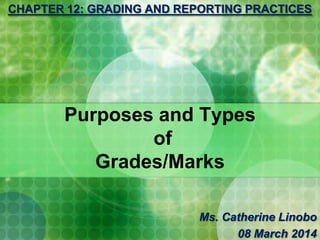
Types and purposes of grades final report
- 1. Purposes and Types of Grades/Marks CHAPTER 12: GRADING AND REPORTING PRACTICES Ms. Catherine Linobo 08 March 2014
- 2. Grades provide information. A grade assigned to a student serves multiple purposes depending on who views it. By S.D. Powell — Pearson Allyn Bacon Prentice Hall
- 4. MAIN POINT #1: Purposes of Grades/Marks 1. Enhancing students’ learning. 2. Reports to parents/guardians. 3. Administrative and guidance uses.
- 5. Purposes of grading and reporting: To communicate the achievement status of the students to their parents and other stakeholders. To provide information that can be used by the students for self-evaluation. To select, identify, or group students for certain educational programs;
- 6. Purposes of grading and reporting: To provide incentives for students to learn. To evaluate the effectiveness of instructional programs and To provide evidence of the students’ lack of effort or inappropriate responsibility.
- 7. MAIN POINT #2: Types of Grades/Marks Percentage System (75-100) Pass or Fail Vocational courses Higher level courses like Math and Physics Five Point Multiple Scale
- 8. Dual System Combination of previous 3 types Letter grade or percentage system- academic subjects. P-F for non-academic and vocational courses Checklist and Rating Scales Early elementary grades
- 9. Percentage grading Using a percentage scale (percent of 100), usually based on percent correct on exams and/or percent of points earned on assignments Most common method in use in high schools and grading colleges c.1890–1910. Used today as a grading method or as a way of arriving at letter grades.
- 10. Letter grading and variations Using a series of letters (often A, B, C, D, F) or letters with plusses and minuses as an ordered category scale - can be done in a norm- referenced (standards- based) manner Yale used a four- category variations system in 1813. In the 1920 letter grading was seen as the solution to the problem of reliability of percentage grading (fewer or criterion- referenced categories) and was increasingly adopted.
- 12. Mastery grading Grading students as “masters” or “passers” when their attainment reaches a prespecified level, usually allowing different amounts of time for different students to reach mastery Originating in the 1920s (e.g., Morrison, 1926) as a grading strategy, it became associated with the educational strategy of mastery learning (Bloom, Hastings, & Madaus, 1971).
- 13. Pass/Fail Using a scale with two levels (pass and fail), sometimes in connection with mastery grading In 1851, the University of Michigan experimented with pass/fail grading for classes.
- 14. Standards (or Absolute- Standards) grading Originally, comparing student performance to a preestablished standard (level) of performance; currently, standards grading sometimes means grading with reference to a list of state or district content standards according to preestablished performance levels Grading according to standards of performance has been championed since the grading 1930s as more educationally sound than norm-referenced grading.
- 15. Narrative grading Writing comments about students’ achievement, either in addition to or instead of using numbers or letters Using a normal instructional practice (describing students’ work) in an assessment context.
- 16. Lesson Review 1. What are the purposes for grading students? 2. What are the types of grading? 3. What is the relevance of this lesson to the educative process?
- 17. Lesson Plan Overview: This lesson provides basic information on the purposes and types of grading. Time: 20-25 minutes Educational Goal: The goal of this lesson is for each student to (1) Comprehend the purposes and types of grading. (2) Appreciate the importance of appropriate grading and reporting.
- 18. Objective: The objective of this lesson is for each student to: (1) comprehend the purposes and types of grading. (2) respond to the value of appropriate grading and reporting. The student will: Cognitive: Explain the purposes and types of grading. Affective: Appreciate the value of appropriate grading.
- 19. Teaching Strategy: This lesson briefly introduces the students to the purposes and types of grading or marks. It is emphasized as the sub-topic of grading and reporting practices. The lesson approach is to discuss each purpose and type, allowing the students to develop a good grasp of each so that they could apply it in their future or present teaching professions. The students should be encouraged to pass their learning to their colleagues and others.
